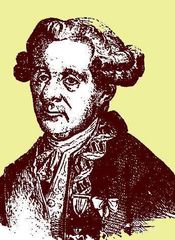
Leopoldo de Gregorio, Marquis of Esquilache
Encyclopedia

Squillace
Squillace is an ancient seaside town and comune, in the Province of Catanzaro, part of Calabria, southern Italy, facing the Gulf of Squillace....
, was an Italian statesman who acted as minister of Charles III of Spain
Charles III of Spain
Charles III was the King of Spain and the Spanish Indies from 1759 to 1788. He was the eldest son of Philip V of Spain and his second wife, the Princess Elisabeth Farnese...
.
Born in Messina, de Gregorio was one of Enlightenment Spain's
Enlightenment Spain
The Age of Enlightenment came to Spain in the eighteenth century with a new Bourbon dynasty after the decay of the Spanish economy, bureaucracy, and empire in the latter years of the former Habsburg dynasty...
leading statesmen from the arrival of Charles III to the Marquis's death in 1785. His ability as a military supplier for the Neapolitan army impressed the king and raised him to royal prominence. He was created "Marquis of Esquilache" in 1755.
Charles III had been introduced to reform by his mentor in Sicily, Bernardo Tanucci
Bernardo Tanucci
Bernardo Tanucci was an Italian statesman, who brought enlightened government to the backward Kingdom of the Two Sicilies for Charles III and his son Ferdinand IV.-Biography:...
. Although Tanucci remained behind in the Two Sicilies to advice Charles's son, King Ferdinand I of the Two Sicilies
Ferdinand I of the Two Sicilies
Ferdinand I reigned variously over Naples, Sicily, and the Two Sicilies from 1759 until his death. He was the third son of King Charles III of Spain by his wife Maria Amalia of Saxony. On 10 August 1759, Charles succeeded his elder brother, Ferdinand VI, as King Charles III of Spain...
, as the two thrones could not be united by consequence of treaty, Charles carried with him a cadre of Italian reformers who saw potential in the Spanish bureaucracy for modernization. De Gregorio was one of them, and was the architect of the first phase of Charles' reforms.
His attempt to modernize the apparel of the average Spaniard resulted in the Esquilache Riots
Esquilache Riots
The Esquilache Riots occurred in March 1766 during the rule of Charles III of Spain. Caused mostly by the growing discontent in Madrid about the rising costs of bread and other staples, they were sparked off by a series of measures regarding Spaniards' apparel that had been enacted by Leopoldo de...
and in his dismissal. Charles was forced to make Esquilache ambassador to Venice
Republic of Venice
The Republic of Venice or Venetian Republic was a state originating from the city of Venice in Northeastern Italy. It existed for over a millennium, from the late 7th century until 1797. It was formally known as the Most Serene Republic of Venice and is often referred to as La Serenissima, in...
. It was a move that both Charles and Esquilache lamented. Esquilache felt that his measures in Spain had deserved a statue
Statue
A statue is a sculpture in the round representing a person or persons, an animal, an idea or an event, normally full-length, as opposed to a bust, and at least close to life-size, or larger...
, and would comment that he had cleaned and paved the city streets and had created boulevard
Boulevard
A Boulevard is type of road, usually a wide, multi-lane arterial thoroughfare, divided with a median down the centre, and roadways along each side designed as slow travel and parking lanes and for bicycle and pedestrian usage, often with an above-average quality of landscaping and scenery...
s, and had nevertheless been dismissed.
He died in Venice
Venice
Venice is a city in northern Italy which is renowned for the beauty of its setting, its architecture and its artworks. It is the capital of the Veneto region...
.

